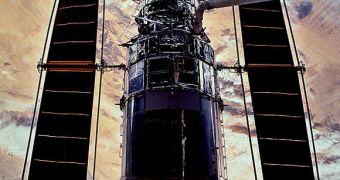The long-postponed mission to repair the Hubble Space Telescope is finally entering a straight line. Next week, the Atlantis space shuttle will be rolled out to Launch Pad 39A at the Kennedy Space Center in Florida. The mission will outfit the old telescope with two new instruments, and will also replace two damaged ones. Additional components will be swapped as well, so as to ensure that the observatory can function properly at least until 2014.
This is the fifth and final mission to repair the Hubble, and the work will be done during five spacewalks. However, STS-125 is a very dangerous flight, on account of the fact the astronauts onboard Atlantis will have no “security net” to rely on if something goes wrong.
Other shuttle missions depended on the ISS to provide temporary shelter if, for example, their heat shields were to get damaged during ascent. But since this option is not available for Atlantis, NASA has decided to have another shuttle in stand-by, to mount a rescue mission if needed.
According to mission planners, STS-125 will last for 11 days, during which time the seven-astronaut crew will have to complete all maintenance work on the Hubble. The crew will be comprised of commander Scott D. Altman, pilot Gregory C. Johnson, and mission specialists Michael T. Good, K. Megan McArthur, John M. Grunsfeld, Michael J. Massimino, and Andrew J. Feustel.
The mission is due to carry the “Soft-Capture Mechanism,” a construction that would make it easier for a spacecraft to dock to the Hubble at the end of the observatory's life, when it's scheduled to leave orbit. When this happens, the attached craft will guide the telescope on the right path as it reenters the atmosphere. The SCM has many mechanisms designed to make automated docking as easy as possible.
The Cosmic Origins Spectrograph is one of the two new instruments that will be installed on the telescope, and it is bound to allow for a 30-times-more sensitivity to far-UV wavelengths. The Wide Field Camera 3 is the second instrument to be added to the Hubble, and it will allow the observatory to take much wider pictures, in a broad series of wavelengths, ranging from infrared to ultraviolet, and including all visible light.
The Endeavor space shuttle will remain on stand-by on Launch Pad 39B during the Atlantis flight, ready to assist if any failure, mechanical or otherwise, occurs while the repair mission moves to orbit. There have been, however, a few problems until NASA officials have come to this result. Launch Pad 39B was supposed to go to the ARES I project, in that the new delivery system should have been tested in mid-summer, but authorities deemed that the security of STS-125 was a priority.

 14 DAY TRIAL //
14 DAY TRIAL //